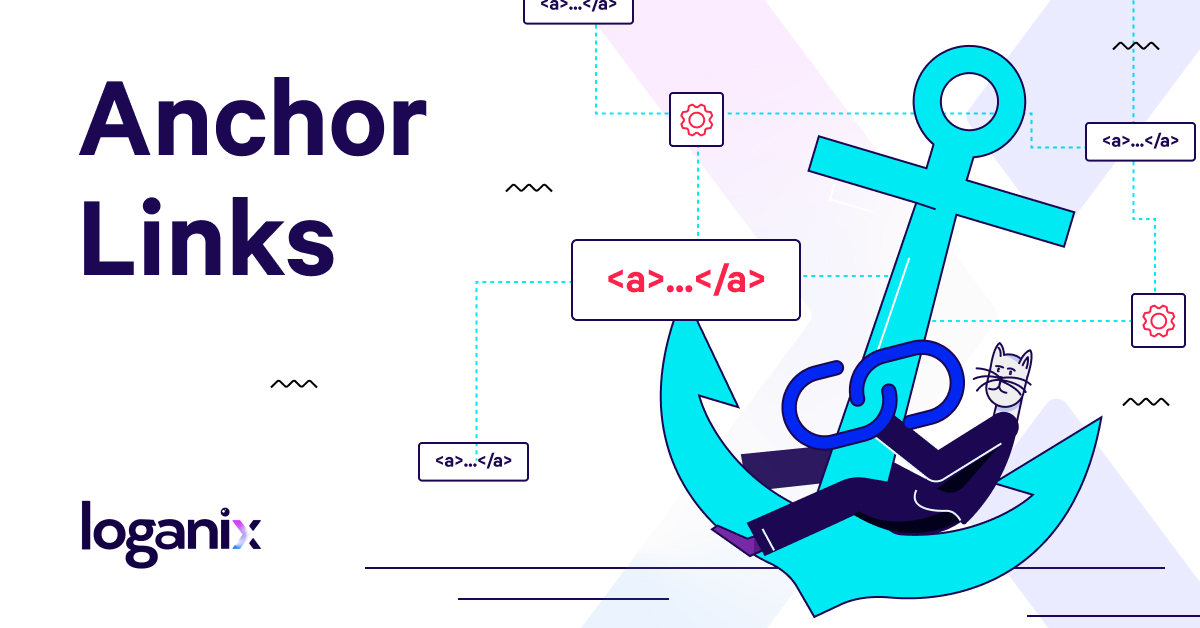What Is An Anchor Link? (+ How They Work for SEO)

Hand off the toughest tasks in SEO, PPC, and content without compromising quality
Explore ServicesWith all the focus on optimizing your website for search engines, it can be easy to forget that the ultimate goal of SEO is to create the best possible experience for real users. Search engines want to deliver content that users find useful and relevant, so optimizing for search engines also means optimizing for humans.
That’s why we’ve decided to write a deep dive on anchor links, which are a great type of link to use from both a user experience and SEO perspective. An anchor link is a type of link that connects content on one part of a page to another part of the page, making it easy to find information quickly.
What Are Anchor Links?
Anchor links, also sometimes referred to as anchor tags or jump links, are elements on a page that are linked to elements elsewhere on the same page. A single anchor link functions as a button that users can click to jump to the linked section of the page, saving them from having to scroll through a long page to identify the part they’re looking for.
Multiple anchor links used together can function as an interactive table of contents. Like a table of contents in a book that indicates which page to go to for the start of each chapter, a table of continents made up of anchor links on a web page provides links to the start of each section.
If you’ve ever searched for a recipe online and found yourself on a food blog you’ve probably felt relief at the sight of this anchor link:

Image Source: Cookie and Kate
The “Jump To Recipe” button is an example of an anchor link that lets visitors navigate directly to the recipe, skipping the lengthy keyword-laden preamble that bloggers include to help get their websites discovered.
Users get the benefit of being able to find the exact content they’re looking for without too much scrolling, while the creator of the webpage can still include as much content as they would like to fill out their page.
Plus, Google’s bots will have an extra clue that the recipe portion of this webpage is particularly important and relevant to readers. We’ll get more into the SEO perks of using anchor links in a moment.
Here is how a table of contents using anchor links can look:

Image Source: Masterclass
The text of the anchor links helps visitors to this page be able to easily see at a glance what the page contains, and what kind of information they can expect to learn if they read through the whole thing. Since these are anchor links, it’s easy to jump to any section that is of particular interest.
Benefits of Using Anchor Links
Using anchor links is favorable both from the perspective of your website visitors and in terms of optimizing for search engines.
Improved UX
From a user experience perspective, anchor links are a fantastic addition to most web pages. If you have a long page with many sections, anchor links provide users with an intuitive, speedy way to navigate.
In internet time, each second is significant. If a user can’t find what they’re looking for in a few seconds, they might click away and try a different source. Providing visitors with a super-fast and efficient way to locate what they’re looking for can increase the amount of time they spend on your site, in turn boosting your conversions.
Plus, you can use anchor links to guide users toward your call to action, making it easier for them to take the necessary action to convert.
In the above example from Masterclass, the anchor link called “Ready to Give Your Space a Chic Update?” takes users to a section that explains their annual membership, nudging them to sign up and making it easy to sign up in a few clicks rather than having to navigate around the website.
Anchor links and SEO
When Google’s bots crawl a webpage, they don’t only look for outbound links linking to external webpages. They also crawl for internal links, including anchor links. Anchor links provide Google with a clue about what is most important on a web page, and they also help the bots understand the structure of a webpage. In other words, anchor links make it easier for Google to get an accurate read of what your webpage contains so that they’re more likely to show your webpage as a result to a relevant search query.
Google’s algorithms are always being updated, and recent updates suggest that elements like anchor links are becoming more important from an SEO perspective. While they may not be a direct ranking factor (meaning, more anchor links don’t automatically result in an SEO boost), they are an indirect ranking factor that can drive real results.
Google’s 2021 Core Web Vitals algorithm update highlights the increased importance of user interactivity on search rankings:
“This past May, we announced that page experience signals would be included in Google Search ranking. These signals measure how users perceive the experience of interacting with a web page and contribute to our ongoing work to ensure people get the most helpful and enjoyable experiences from the web.”
This means that Google’s algorithms take into account how visitors interact with a website and how much time they spend on a website. By reducing your bounce rate and inviting interaction in the form of clicks, anchor links are a welcome addition for anyone who wants to give their site an SEO boost.
Anchor links and search snippets
Google search snippets are the little sections that sometimes appear at the top of Google search results, extracting a relevant portion from a webpage to provide an instant response to a query.
Here’s an example:

Image source: Google
This featured snippet is pulled from a Shopify table of contents made up of anchor links in an article about how to write a business plan. Google has long let marketers know that anchor links can become featured snippets.
Using anchor links to create tables of contents with informative, descriptive titles, like the ones in this example, can help boost your chances of landing a featured snippet. Since these are at the top of their search results pages, they can be a great way to boost visibility and get more traffic to your website.
How To Create Anchor Links
While it’s pretty easy to create anchor links in HTML, chances are your page builder has a built-in function for creating anchor links.
For example, in WordPress, under advanced settings when editing a block you’ll see a section called HTML anchor:
- Give the section you want to link to a name. This anchor name is for your reference and is not visible on the front end of your site.
- To create the link, highlight the text or object you want to use as an anchor link.
- Select the create link icon.
- Enter a # sign followed by the name you have your anchor.
The process in Shopify and many other page builders is very similar. You’ll create an ID for the block you want to link to, then use that ID as the link destination.
Anchor Links Best Practices
It should be clear by now that anchor links are an easy-to-implement yet powerful tool to use when creating content for your website. However, using them correctly is important and can help you (and your site visitors!) get the most out of your anchor links.
Choose appropriate anchors
Firstly, make sure you’re attaching your anchor links to your headings and subheadings rather than to smaller sections mid-content. Since website visitors and Google’s bots will both scan your anchor links to figure out what the most important information on a page is, you want to provide an accurate picture by anchoring your links to important sections like headings.
This also means that to get the most SEO and UX benefit from your anchor links, it’s key that your headings are well-written. They should incorporate appropriate keywords and be informative so that it’s easy to understand exactly what kind of information can be found in each section.
Loganix’s keyword gap analysis can help you identify the keywords that you’re most likely to rank for, so you can incorporate them in your headings and anchor text for more SEO impact.
Take note of common usage
Understanding how others use anchor links can make it easier to determine how to work them into your own content. Some of the best ways to use anchor links include:
- Table of contents – We’ve talked about the many ways having a table of contents made up of anchor links can improve your website: it makes navigation a breeze, reduces bounce rates, and lets Google’s crawlers know what your page contains. If you have blog posts, service pages, or just about any other kind of content on your website, use anchor links to create a table of contents.
- CTAs – anchor links can be an effective way to take visitors right to the place where they can convert. Like the Masterclass example we looked at, anchor links provide a way for motivated prospective clients or customers to convert more easily, by skipping through content.
- Landing pages and single-page layouts – long landing pages and single-page websites are appropriate for some businesses, but make sure you don’t overwhelm your visitors by making it easy for them to find what they need without having to scroll through thousands of pixels to find it.
- Scroll to bottom and scroll to top buttons – another good use of anchor links is as buttons that let visitors jump to the top or bottom of the page. Whether they want to return to the start of your content or they want to see the information in your footer, adding these anchor links can make for improved UX.
- Jump to X – we get it, sometimes you need to fill your page with a lot of copy in order to make it more discoverable by search engines and, in turn, your target customers. This can be the case even when you know most of your visitors only care about one small piece of content on your page. The “Jump to Recipe” example is the perfect example of this use of anchor links. Adding that link makes for a much better experience for visitors who want to cut to the chase.
Summary
Anchor links are a fantastic way to make your website easier to navigate, and more SEO-friendly. It’s easy for people to get distracted online, so incorporating anchor links into your content gives your visitors an easy way to find exactly what they’re looking for fast.
Plus, you can give Google an extra clue about what exactly is contained on your page, so their algorithm will be more likely to show your page as a result for relevant queries.
What to craft content that your customers and Google will love, so you can start effectively using anchor links throughout your site? Loganix’s blog writing services make it easy. Or, if you want us to do all the heavy lifting for you so you focus on growing your business while we focus on improving your SEO rankings, check out our comprehensive SEO packages.
Hand off the toughest tasks in SEO, PPC, and content without compromising quality
Explore ServicesWritten by Adam Steele on December 9, 2022
COO and Product Director at Loganix. Recovering SEO, now focused on the understanding how Loganix can make the work-lives of SEO and agency folks more enjoyable, and profitable. Writing from beautiful Vancouver, British Columbia.





